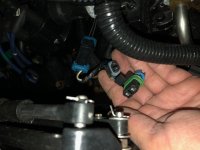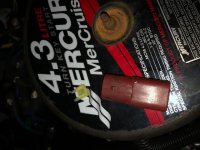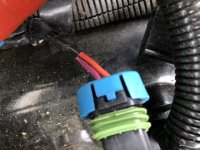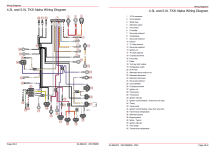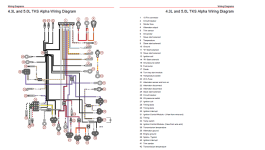Hey team - long time reader, 1st time poster here. I have a 2006 Bayliner with a 2005 Mercruiser 4.3l with TKS. Not too long ago, the oil pump shaft sheared (yep sheared) and the oil pump quit. I had my mechanic pull the engine & replace the oil pump. Put it back in the water and runs like a champ! About a month ago, he dropped off the boat and within the past week, I was working on getting it ready for the season. I went to turn the key, no power. BTW - the battery was replaced when the oil pump was replaced. I hooked the [COLOR=#67B045 !important]charger[/COLOR] up and it turns out the battery was dead. Odd since the battery was new. I turned the key to on and there was power to the dash. Turned the key off and could hear a noise coming from the engine bay. It was my fuel pump. It runs 24/7 with the key on or off. I removed the maroon TKS diode and the pump shut off so that I could charge my battery and avoid an unsafe [COLOR=#67B045 !important]condition[/COLOR]. Plug the diode in, fuel pump starts up regardless of key position. One more thing to add...before I realized the battery was dead, I checked all of the [COLOR=#67B045 !important]fuses[/COLOR]. The only bad [COLOR=#67B045 !important]fuse[/COLOR] I could find was the 20a fuse in the plug that is located next to the diode plug. Any thoughts? Thanks! Chris
Home
Outboard Motor Parts
Chrysler outboard parts Evinrude outboard parts Force outboard parts Honda outboard parts Johnson outboard parts Mariner outboard parts Mercury outboard parts Suzuki outboard parts Tohatsu outboard parts Yamaha outboard partsInboard & Sterndrive Engine Parts
Chrysler Marine inboard parts Crusader Marine parts MerCruiser sterndrive parts OMC sterndrive parts Pleasurecraft Marine parts Volvo Penta marine parts + MoreAll Engine Brands
All Manuals HomeOutboard Repair Manuals
Chrysler outboard manuals Evinrude outboard manuals Force outboard manuals Honda outboard manuals Johnson outboard manuals Mariner outboard manualsMercury outboard manuals Nissan outboard manuals Suzuki outboard manuals Tohatsu outboard manuals Yamaha outboard manuals
Inboard & Sterndrive Engine Manuals
MerCruiser sterndrive manuals OMC sterndrive manuals Volvo Penta marine engine manualsPlease Note
MarineEngine.com does not offer troubleshooting assistance or repair advice by email or by telephone.
You are invited to join our public Boat Repair Forum to seek assistance from other members.
You may also visit the Boat Motor Manuals section of our site to obtain a service manual.


